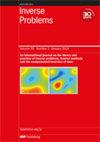用于弹性障碍物识别的基尔霍夫迁移方案
IF 2
2区 数学
Q1 MATHEMATICS, APPLIED
引用次数: 0
摘要
基尔霍夫迁移(Kirchhoff Migration,KM),有时也称为到达(或移动)时间成像(Arrival (or Travel) Time Imaging),是一种基于波从给定源到达给定传感器的时间的基本且流行的成像技术。它通常用于水下声学和固体地球物理学领域,既可用于地下结构分析,也可用于识别介质中未知的局部障碍物(散射体)。本文主要讨论后一种应用。在声学方面,KM 算法非常简单高效,尽管它通常生成的图像相当粗糙,这也是它在不需要高分辨率时作为首选方法,或作为为更复杂的成像方法生成初始猜测的快速技术的原因。对于弹性而言,KM 涉及的问题要多得多,因为到达时间算法并不明显,主要是因为每个空间点的波速不止一种。本文提出了一种新的 KM 方案,用于在各向同性的片状均质弹性介质中识别障碍物。该方案基于测量与 P 波和 S 波相关的位移场二阶算子的两个量,并将声学 KM 算法与适当的波速分别应用于这两个量。数值结果表明,与 S 波相关的算子在许多情况下都能实现很好的识别。基于 S 波相关算子的测量结果优于基于 P 波相关算子的测量结果,这是一个经验观察结果,有待全面分析,但本文给出了部分解释。本文章由计算机程序翻译,如有差异,请以英文原文为准。
A Kirchhoff Migration scheme for elastic obstacle identification
Kirchhoff Migration (KM), sometimes called Arrival (or Travel) Time Imaging, is a basic and popular imaging technique based on the arrival time of waves from given sources to given sensors. It is commonly used in the fields of underwater acoustics and solid earth geophysics, for both subsurface structure analysis and for identifying unknown local obstacles (scatterers) in the medium. The present paper concentrates on the latter application. For acoustics, the KM algorithm is extremely simple and efficient, although it usually produces a rather crude image, which is the reason for its use as the method of choice when high resolution is not needed, or as a fast technique to produce an initial guess for a more sophisticated imaging method. For elasticity, KM is much more involved, as the arrival-time algorithm is not obvious, mainly since there is more than one wave speed at each spatial point. In this paper, a new KM scheme is proposed for obstacle identification in an isotropic piecewise-homogeneous elastic medium. The scheme is based on measuring two quantities that are second-order operators of the displacement field, which are related to P and S waves, and applying the acoustic KM algorithm to each of them, with the appropriate wave speed. It is demonstrated numerically that the operator related to S waves results in very good identification in many cases. The fact that measurements based on the S-related operator are preferred over those based on the P-related operator is an empirical observation, and awaits full analysis, although a partial explanation is given here.
求助全文
通过发布文献求助,成功后即可免费获取论文全文。
去求助
来源期刊

Inverse Problems
数学-物理:数学物理
CiteScore
4.40
自引率
14.30%
发文量
115
审稿时长
2.3 months
期刊介绍:
An interdisciplinary journal combining mathematical and experimental papers on inverse problems with theoretical, numerical and practical approaches to their solution.
As well as applied mathematicians, physical scientists and engineers, the readership includes those working in geophysics, radar, optics, biology, acoustics, communication theory, signal processing and imaging, among others.
The emphasis is on publishing original contributions to methods of solving mathematical, physical and applied problems. To be publishable in this journal, papers must meet the highest standards of scientific quality, contain significant and original new science and should present substantial advancement in the field. Due to the broad scope of the journal, we require that authors provide sufficient introductory material to appeal to the wide readership and that articles which are not explicitly applied include a discussion of possible applications.
 求助内容:
求助内容: 应助结果提醒方式:
应助结果提醒方式:


